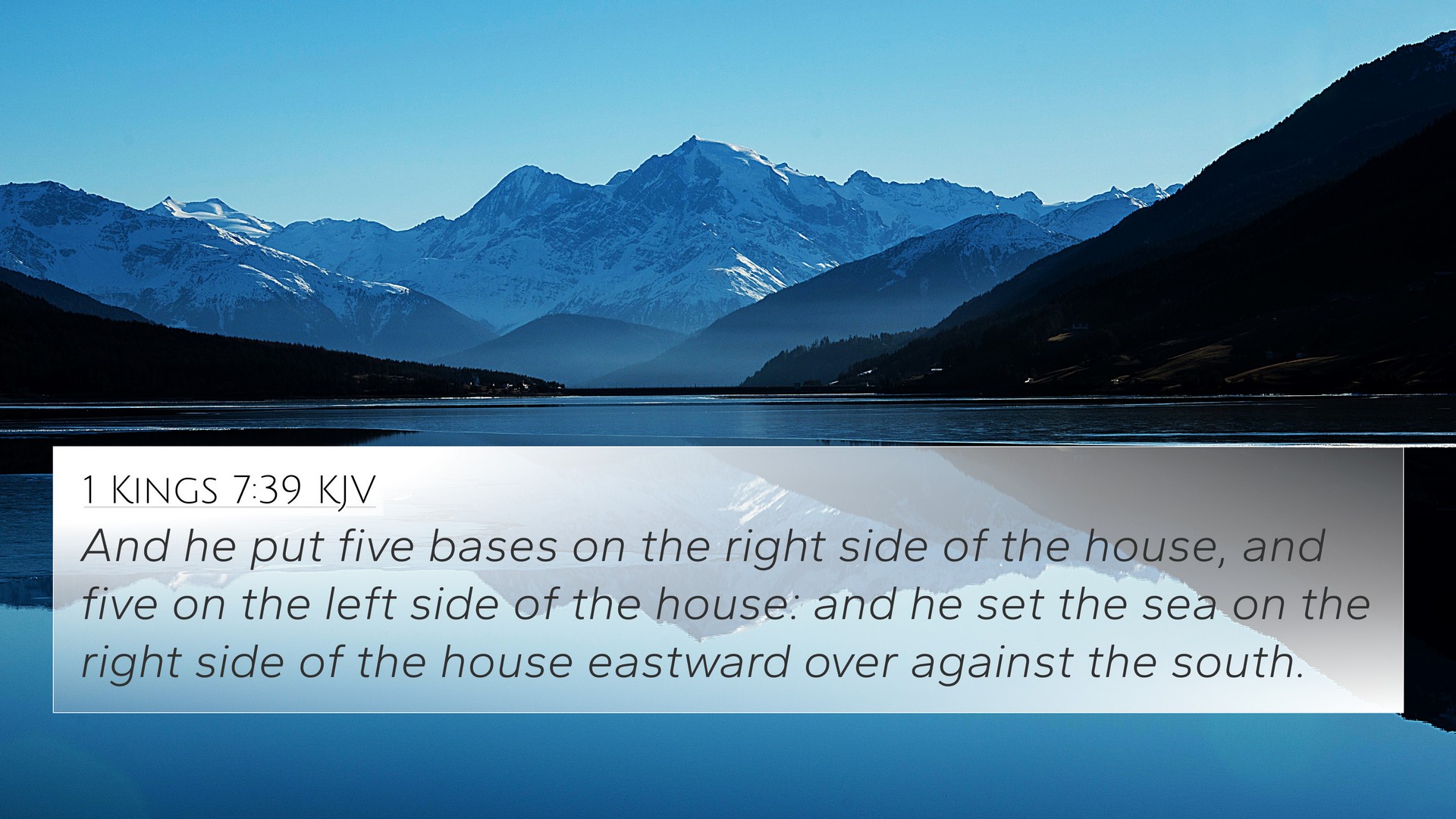Understanding 1 Kings 7:39
This passage from 1 Kings 7:39 describes the intricate details of the temple built by King Solomon, particularly focusing on the design and structure of the brazen sea and the bases that supported the various elements of the temple.
Verse Text
"And he put five bases on the right side of the house, and five on the left side of the house: and he set the sea on the right side of the house eastward, over against the south."
Summary of Insights from Commentaries
In analyzing this passage, several commentaries provide profound insights:
-
Matthew Henry emphasizes that the construction details are significant not just for architectural reasons but to denote the greatness of God’s dwelling place. The positioning of the sea symbolizes the purification needed for worship.
-
Albert Barnes notes that the number and symmetry of the bases highlight the order and beauty required in God’s house. He suggests this illustrates God’s glory manifesting in an organized and awe-inspiring way.
-
Adam Clarke reflects on the practical use of the brazen sea, which functioned as a large basin for ceremonial washing, signifying the theme of holiness in approaching God. Clarke also mentions the geographical positioning hinting at deeper theological implications regarding access to God.
Thematic Connections
This verse has a multitude of thematic connections and reflects broader biblical narratives. Below are several areas of cross-reference:
- Exodus 30:18: Discusses the labor and its significance in the tabernacle.
- 2 Chronicles 4:6: Details similar features of Solomon's temple that resonate with this passage.
- Psalms 84:1-2: Expresses the beauty of God’s dwelling place, connecting to the temple's description.
- Hebrews 9:1-5: Provides insight into the symbolism of the earthly tabernacle and its vessels.
- Revelation 21:22: Contrasts earthly temples with the New Jerusalem, highlighting the ultimate divine presence.
- Isaiah 66:1-2: Speaks to the eternal nature of God and how His glory transcends earthly structures.
- 1 Peter 2:5: Relates the idea of believers as living stones, forming a spiritual house.
Cross-Referencing Biblical Texts
Understanding 1 Kings 7:39 can be enhanced through various methods of cross-referencing:
- Tools for Bible cross-referencing: Utilize tools like a Bible concordance to identify parallels and patterns across scripture.
- Bible cross-reference guide: Implement comprehensive guides that showcase thematic connections across both Testaments.
- Cross-reference Bible study: Engage in methods that help break down scripture comparisons for deeper learning.
- Bible reference resources: Make use of resource collections that help compile inter-Biblical dialogues.
- Comparative Bible verse analysis: Analyze the similarities and differences between parallel scriptures for an enriched understanding.
- Identifying connections between Old and New Testament: Explore how themes from the Old Testament, such as sanctity and worship practices, re-enter in the context of the New Testament.
- Cross-referenced themes in the Bible: Delve into thematic studies that center around worship and holiness across the biblical narrative.
User Intent Keywords
If you’re searching for connections, consider:
- What verses are related to 1 Kings 7:39? Look to Exodus and Psalms for direct thematic parallels.
- Find cross-references for specific scripture explorations.
- How do specific verses like Revelation 21:22 connect back to Old Testament imagery?
- Analyze the similarities between the temple’s physical representations vs spiritual implications across scripture.
- Explore Bible verses that support purification themes in approaching God.
Conclusion
In conclusion, 1 Kings 7:39 is a verse rich with architectural detail and deep spiritual significance. The insights drawn from public domain commentaries illustrate the beauty and intentionality behind the structures of Solomon's temple, encouraging readers to pursue further study through cross-referencing biblical texts. By exploring the interconnectedness of scripture, one can fully appreciate the profound layers of meaning embedded in even a single verse, enhancing our understanding of God’s nature and His desires for worship.




